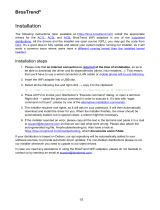
Public-Key Cryptography .............................................................................................................. 5-6
The Apache Web Server ...................................................................................................................... 5-6
Editing the Server Name in the Configuration File ............................................................................ 5-7
SFTP ................................................................................................................................................. 5-7
DNS .................................................................................................................................................. 5-8
/etc/hosts .................................................................................................................................. 5-8
/etc/resolv.conf ........................................................................................................................... 5-8
/etc/nsswitch.conf ....................................................................................................................... 5-8
iptables ............................................................................................................................................. 5-9
Observing and Erasing Chain Rules .............................................................................................. 5-12
Defining a Policy for Chain Rules ................................................................................................. 5-12
Append or Delete Rules .............................................................................................................. 5-13
rsync............................................................................................................................................... 5-13
Using rsync for External Backups ................................................................................................. 5-14
Automating rsync Backups ......................................................................................................... 5-14
NAT ................................................................................................................................................ 5-15
NAT Example ............................................................................................................................ 5-15
Enabling NAT at Bootup ............................................................................................................. 5-16
NFS (Network File System) ................................................................................................................ 5-17
Setting Up the UC-8100-LX as an NFS Client ................................................................................ 5-17
SNMP .............................................................................................................................................. 5-17
OpenVPN ......................................................................................................................................... 5-19
Static-Key VPN .......................................................................................................................... 5-19
Package Management........................................................................................................................ 5-20
apt-get .................................................................................................................................... 5-20
apt-cache ................................................................................................................................. 5-20
List All Available Packages .......................................................................................................... 5-20
Find Package Name and Software Description ............................................................................... 5-20
Check Package Information ........................................................................................................ 5-21
Check Dependencies for Specific Packages ................................................................................... 5-21
Check Cache Statistics ............................................................................................................... 5-21
Update System Packages ........................................................................................................... 5-21
Install or Upgrade Specific Packages ............................................................................................ 5-21
Upgrade All Software Packages ................................................................................................... 5-21
Install Multiple Packages ............................................................................................................ 5-21
Install Packages without Upgrading ............................................................................................. 5-21
Upgrade Specific Packages ......................................................................................................... 5-22
Install Specific Package Version .................................................................................................. 5-22
Remove Packages Without Configuration ...................................................................................... 5-22
Completely Remove Packages ..................................................................................................... 5-22
Clean Up Disk Space .................................................................................................................. 5-22
Download Only Source Code of Package ....................................................................................... 5-22
Download and Unpack a Package ................................................................................................ 5-22
Download, Unpack, and Compile a Package .................................................................................. 5-22
Download a Package Without Installing ........................................................................................ 5-23
Check the Package Change Log ................................................................................................... 5-23
Check Broken Dependencies ....................................................................................................... 5-23
Search and Build Dependencies ................................................................................................... 5-23
Auto Clean Apt-Get Cache .......................................................................................................... 5-23
Auto Remove Installed Packages ................................................................................................. 5-23
6. Programmer’s Guide ......................................................................................................................... 6-1
Linux Tool Chain Introduction ............................................................................................................... 6-2
Native Compilation ...................................................................................................................... 6-2
Cross Compilation ....................................................................................................................... 6-2
Cross Compiling Applications and Libraries ..................................................................................... 6-4
Test Program—Developing Hello.c ......................................................................................................... 6-4
Compiling Hello.c Using Native Compilation .................................................................................... 6-4
Compiling Hello.c Using Cross Compilation...................................................................................... 6-5
Makefile Example ................................................................................................................................ 6-6
Modbus ............................................................................................................................................. 6-6
RTC (Real Time Clock) ......................................................................................................................... 6-6
WDT (Watchdog Timer) ....................................................................................................................... 6-8
Cryptographic Hardware Accelerator ..................................................................................................... 6-9
Diagnostic LED ................................................................................................................................... 6-9
Turning on the LEDs .................................................................................................................... 6-9
Turning off the LEDs .................................................................................................................... 6-9
Blinking the LEDs ........................................................................................................................ 6-9
Using cell_mgmt ............................................................................................................................... 6-10
Manual Page ............................................................................................................................. 6-10
Automatic Dial-Up ..................................................................................................................... 6-12
Cellular Module ......................................................................................................................... 6-13
cell_mgmt at ['AT_COMMAND'] ................................................................................................... 6-14





















